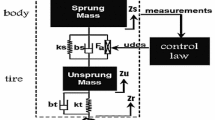Abstract
A novel intelligent semi-active control system for an eleven degrees of freedom passenger car’s suspension system using magnetorheological (MR) damper with neuro-fuzzy (NF) control strategy to enhance desired suspension performance is proposed. In comparison with earlier studies, an improvement in problem modeling is made. The proposed method consists of two parts: a fuzzy control strategy to establish an efficient controller to improve ride comfort and road handling (RCH) and an inverse mapping model to estimate the force needed for a semi-active damper. The fuzzy logic rules are extracted based on Sugeno inference engine. The inverse mapping model is based on an artificial neural network and incorporated into the fuzzy controller to enhance RCH. To verify the performance of the NF controller (NFC), comparisons with existing semi-active techniques are made. The typical control strategy are linear quadratic regulator (LQR) and linear quadratic Gaussian (LQG) controllers with clipped optimal control algorithm, while inherent time-delay and non-linear properties of MR damper lie in these strategies. Simulation results demonstrated that the NFC has better control performance and less control effort than the optimal in improving the service life of the suspension system and the ride comfort of a car.
Similar content being viewed by others
References
Y. P. Wang, Y. Shio, J. Guo, M. H. Chiang and Y. K. Din, Semi-active control of vehicle suspension system using electrorheological dampers, 3rd Institution of Engineering and Technology Conference (2007).
R. S. Prabakar, C. Sujatha and S. Narayanan, Optimal semiactive preview control response of a half car vehicle model with magnetorheological damper, Journal of sound and vibration, 326 (2009) 400–420.
Y. Md. Sam and J. H. S. B. Osman, Modeling and control of the active suspension system using proportional integral sliding mode approach, Asian Journal of Control, 7(2) (2005) 91–98.
A. F. Jahromi, A. Zabihollah and Linear Quadratic Regulator and fuzzy controller application in full-car model of suspension system with magnetorheological shock absorber, IEEE/ASME International Conference on Mechanical and Embedded Systems and Applications (2010) 522–528.
M. M. M. Salem and Ayman A. Aly, Fuzzy control of a quarter-car suspension system, World Academy of Science Engineering and Technology, 53 (2009) 258–263.
H. C. Sohn and K. T. Hong, An adaptive LQG control for semi-active suspension systems, International Journal Vehicle Design, 34(4) (2004) 309–326.
Y. Chen, Tan, L. A. Bergman and T. C. Tsao, Smart suspension systems for bridge-friendly vehicles, Annual International Symposium on Smart Structures and Materials (2002).
S. Jialin, A. Ordys and K. Panahi, LQR-based linear controller of active suspension on a half-body model for improved ride comfort, 3rd IAR Workshop on Advanced Control and Diagnosis (2008).
J. Sun and Q. Yang, Modeling and intelligent control of vehicle active suspension system, IEEE International conference on RAM (2008) 239–242.
J. Sun, Q. Zhou, Vibration control of vehicle suspension with five degrees of freedom, Proc. 9th IEEE International conference on cognitive informatics (2010) 824–828.
M. Biglarbegian, W. Melek and F. Golnaraghi, Intelligent control of vehicle semi-active suspension system for improved ride comfort and road handling, IEEE International conference (2006) 19–24.
S. H. Sadati, M. A. Shooredeli and A. D. Panah, Designing a neuro-fuzzy controller for a vehicle suspension system using feedback error learning, Journal of mechanics and aerospace, 4(3) (2008) 45–57.
Zh. D. Xu, Y. Q. Guo and Neuro-Fuzzy control strategy for earthquake-excited nonlinear magnetorheological structures, Soil Dynamics and Earthquake Engineering, 28 (2008) 717–727.
O. Yoshida and S. J. Dyke, Seismic control of a nonlinear benchmark building using smart dampers, Journal of engineering mechanics, 130 (2004) 386–392.
A. Khajekaramodin, H. Hajikazemi, A. Rowhanimanesh and M. R. Akbarzade, Semi-active control of structures using neuro-inverse model of MR dampers, 1st Joint congress on fuzzy and intelligent systems, Iran (2007).
S. Yildirim and I. Eski, Vibration analysis of an experimental suspension system using artificial neural networks, Journal of Scientific & Industrial Research, 68 (2009) 522–529.
S. Y. Ok, D. S. Kim, K. S. Park and H. M. Koh, Semiactive fuzzy control of cable-stayed bridges using magnetorheological dampers, Engineering Structures, 29 (2007) 776–788.
V. S. Atray and P. N. Roschke, Neuro-fuzzy control of railcar vibrations using semi active dampers, Computer-Aided Civil and Infrastructure Engineering, 19 (2004) 81–92.
S. G. Foda, Neuro-fuzzy control of a semi-active car suspension system, IEEE conference (2001) 686–689.
S. Yildirim and I. Eski, Vibration analysis of an experimental suspension system using artificial neural networks, Journal of Scientific & Industrial Research, 68 (2009) 522–529.
M. Askari and A. H. Davaie-Markazi, Multi-objective optimal fuzzy logic controller for nonlinear building-MR damper system, 5 th IEEE International Conference on Signals and Devices (2008) 3–8.
M. Ahmadian and C. A. Pare, A quarter car experimental analysis of alternative semi-active control methods, Journal of Intelligent Material Systems and Structures 11(8) (2000) 604–612.
Y. Kim, R. Langari and S. Hurlebaus, Semi-active nonlinear control of a building with a magnetorhelogical damper system, Mechanical Systems and Signal Processing, 23 (2009) 300–315.
R. Stanway, J. L. Sproston and N. G. Stevens, Non-linear modelling of an electrorheological vibration damper, Journal of Electrostatics, 20(2) (1987) 167–184.
Author information
Authors and Affiliations
Corresponding author
Additional information
This paper was recommended for publication in revised form by Associate Editor Hyoun Jin Kim
Seiyed Hamid Zareh is a MSc. Student in Mechatronics at Sharif University of Technology, School of Science and Engineering, Iran. He was born in 1983 and also graduated in mechanical engineering in 2004 at Imam Hossein University of Tehran, Iran.
Rights and permissions
About this article
Cite this article
Zareh, S.H., Sarrafan, A., Khayyat, A.A.A. et al. Intelligent semi-active vibration control of eleven degrees of freedom suspension system using magnetorheological dampers. J Mech Sci Technol 26, 323–334 (2012). https://doi.org/10.1007/s12206-011-1007-6
Received:
Revised:
Accepted:
Published:
Issue Date:
DOI: https://doi.org/10.1007/s12206-011-1007-6




